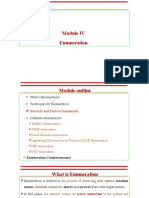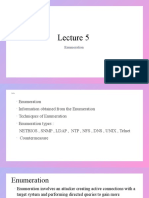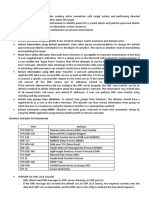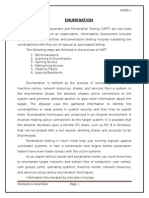0% found this document useful (0 votes)
29 views25 pagesModule 4 - Enumeration
Enumeration is the third phase of penetration testing, focusing on gaining detailed information about a system by exploiting identified vulnerabilities. Techniques include extracting user information, utilizing SNMP and LDAP, and conducting DNS zone transfers. The document also outlines various enumeration methods and their associated risks, emphasizing the importance of countermeasures to protect against these attacks.
Uploaded by
meghanakl1823Copyright
© © All Rights Reserved
We take content rights seriously. If you suspect this is your content, claim it here.
Available Formats
Download as PDF, TXT or read online on Scribd
0% found this document useful (0 votes)
29 views25 pagesModule 4 - Enumeration
Enumeration is the third phase of penetration testing, focusing on gaining detailed information about a system by exploiting identified vulnerabilities. Techniques include extracting user information, utilizing SNMP and LDAP, and conducting DNS zone transfers. The document also outlines various enumeration methods and their associated risks, emphasizing the importance of countermeasures to protect against these attacks.
Uploaded by
meghanakl1823Copyright
© © All Rights Reserved
We take content rights seriously. If you suspect this is your content, claim it here.
Available Formats
Download as PDF, TXT or read online on Scribd
/ 25


















































































